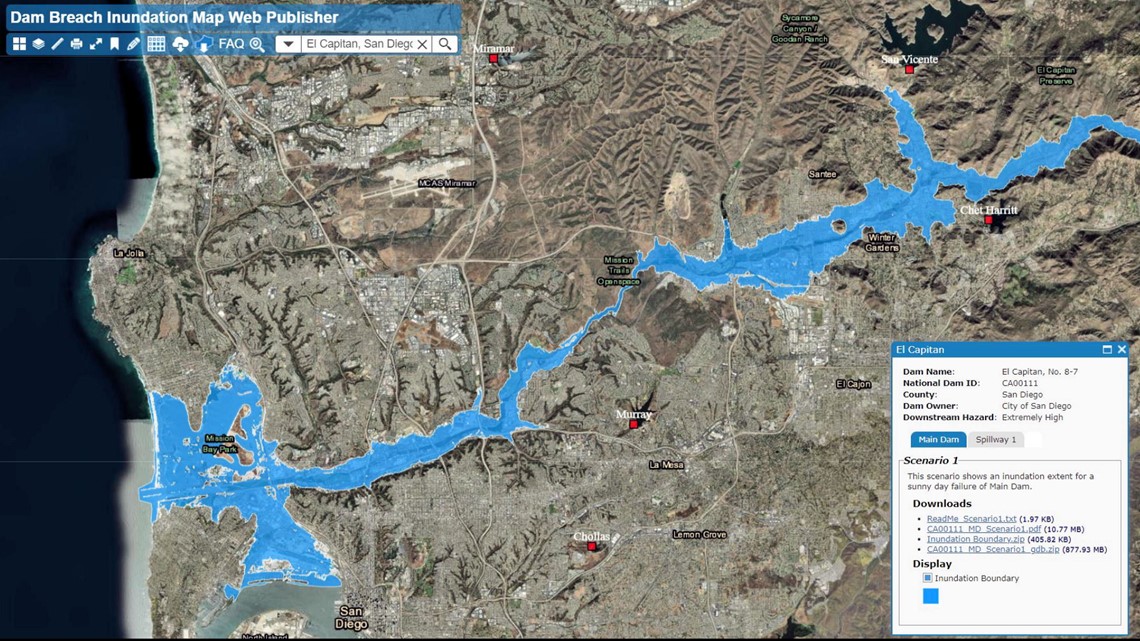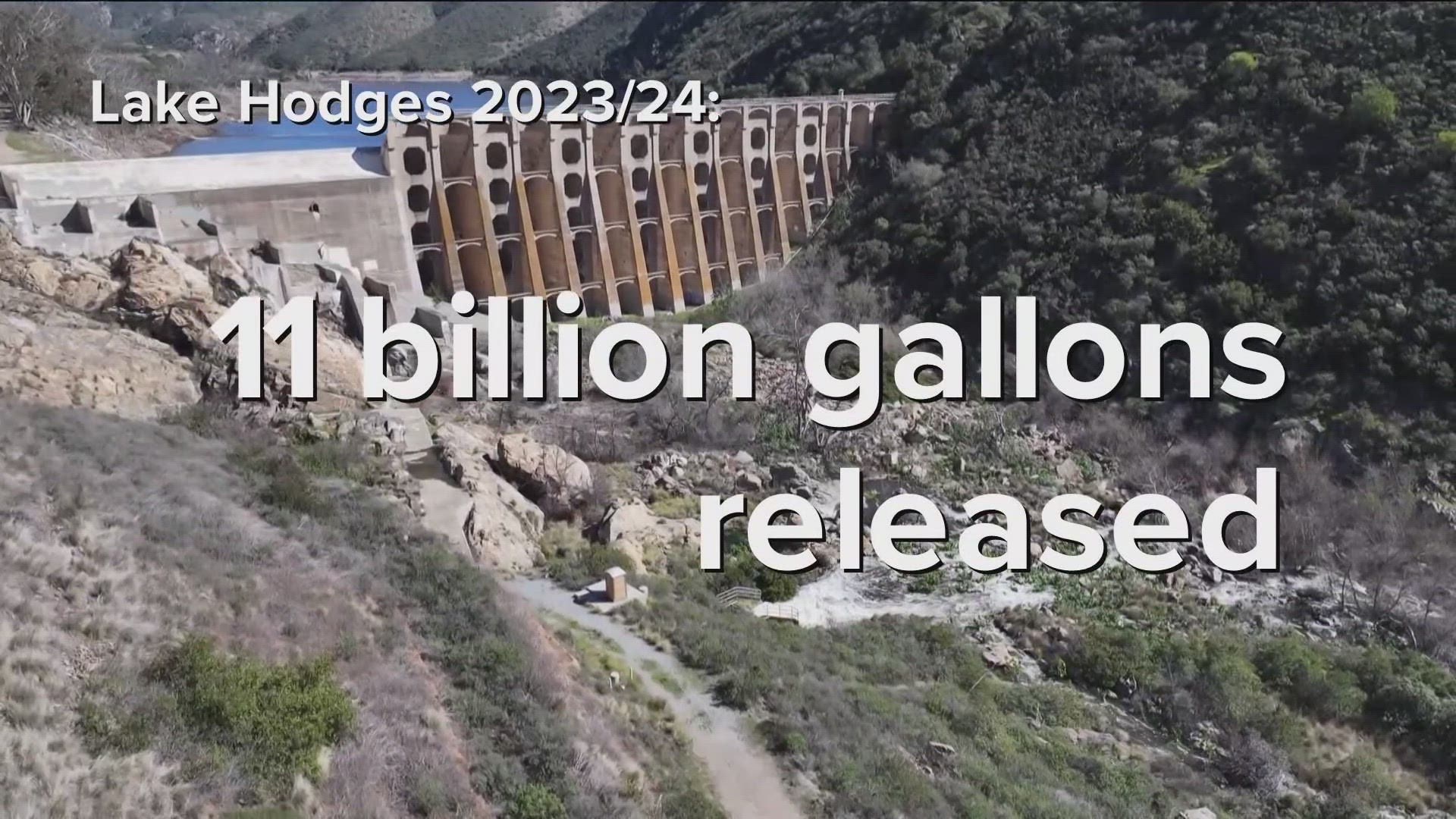SAN DIEGO — Billions of gallons of water have been released into the ocean from local reservoirs over the past year, mainly because of a state order to keep the water levels low.
California's Division of Safety of Dams currently has water level restrictions in place at five reservoirs in San Diego County, aimed at keeping the public safe.
Who can forget the images of the Oroville Dam spillway disintegrating during the 2017 flooding in Northern California? The crisis led to the evacuation of more than 180,000 people living downstream. Fortunately, the dam itself did not collapse.
“I think following Oroville dam safety is at the forefront of the state,” said Sharon Tapia, a division manager at the state’s Safety of Dams agency.
Tapia said that in the wake of Oroville, new legislation was passed allowing for enforcement measures. The agency now requires increased inspections of dams, as well as updated emergency action plans in case a dam fails.
Here in San Diego County, the dam with the lowest rating is Hodges Dam. Built in 1918, its condition is listed as "unsatisfactory" by the Safety of Dams agency due to seismic safety concerns.
“Unsatisfactory is the lowest. And that means it is unsafe to store water at its normal level,” Tapia said.
The water elevation on Lake Hodges has been restricted to 280 feet above sea level since February 2023. As a result, almost every time we get a heavy rainstorm, water has to be released.
In 2023 and 2024 combined, the city of San Diego has released more than 11 billion gallons of water from Lake Hodges into the ocean.
Tapia said the water level restrictions are meant to protect people downstream in the event of a collapse.
“So that if the dam were to have any structural issues occur, then you're going to have less water that's released,” she said.
The Division of Safety of Dams has posted inundation maps online, showing the flood zone that might occur if a dam collapses when its reservoir is full.
The maps depicting a hypothetical collapse of Hodges Dam show a worst-case scenario, where water floods the San Dieguito River, inundating parts of Rancho Santa Fe, Fairbanks Ranch and Del Mar. The Del Mar Fairgrounds are shown covered in water.


With the water level currently restricted to 280 feet, the city of San Diego contends, “There is not an imminent threat of failure of Hodges dam."
Another local dam, El Capitan east of Lakeside, is listed in "poor" condition. It’s the second lowest level on the state’s dam safety scale, again, due to seismic stability issues. “Seismic is a very common one because California has a very active seismic regime,” said Tapia.
El Capitan reservoir's water elevation currently is restricted to 700 feet. In 2023, the city of San Diego said it released six billion gallons of water to keep El Capitan reservoir's water level low.
“That's a lot of water. I didn't really realize how much it was,” said Brenna Drake, who lives downstream from El Capitan Dam.
Right now, the river by her home is dry, but the city said it expects to start releasing water again in the fall.
“I kind of wonder how it's going to impact us down here, sending out the water. And I also worry about the dam, about how good it is because I'm going to have animals down here,” she said.
The city of San Diego said in a statement to CBS 8: "In the fall of 2023, the City released water from El Capitan ahead of the El Niño season, in an effort to create sufficient capacity for precipitation and avoid exceeding the 700-foot mandated restriction level during the likely rainiest months of 2024. We do not anticipate needing to release water from El Capitan Reservoir again until the fall of 2024, at which time determinations for water release will be made based on climate predictions for winter 2025."
The state inundation map depicting a hypothetical collapse of El Capitan Dam with a full reservoir showed massive flooding would occur along the San Diego River, with extreme flooding in Lakeside, El Cajon and Santee; and continuing through Mission Valley all the way to Mission Bay.
The maps also showed San Diego International Airport and the Midway District flooded out.


The five dams in San Diego County with water-level restrictions are listed below, along with information provided by the DSOD in September 2023:
********
Dam Name: Lake Hodges
Dam Number: 8-3
Owner Name: City of San Diego
Condition Assessment: Unsatisfactory
Downstream Hazard Potential Classification: Extremely High
Effective Date of Restriction: February 2, 2023
Reason for Restriction: Seismic
Owner's Reported Planned Action(s): A comprehensive condition assessment and a seismic stability analysis have been completed. Near-term repairs surrounding the dam and spillway apron are being implemented. Long-term improvements are being developed to increase dam safety and performance.
********
Dam Name: El Capitan
Dam Number: 8-7
Owner Name: City of San Diego
Condition Assessment: Poor
Downstream Hazard Potential Classification: Extremely High
Effective Date of Restriction: May 27, 2015
Reason for Restriction: Seismic
Owner's Reported Planned Action(s): An initial geologic and seismic stability evaluation of El Capitan Dam has been completed. Additional analyses will be needed to determine if improvements to the dam are needed to mitigate the seismic stability concern.
********
Dam Name: Morena
Dam Number: 8-5
Owner Name: City of San Diego
Condition Assessment: Poor
Downstream Hazard Potential Classification: Extremely High
Effective Date of Restriction: November 10, 2021
Reason for Restriction: Hydraulic
Owner's Reported Planned Action(s): The City of San Diego will acquire consultant services to perform a comprehensive condition assessment.
********
Dam Name: Murray
Dam Number: 8-12
Owner Name: City of San Diego
Condition Assessment: Fair
Downstream Hazard Potential Classification: Extremely High
Effective Date of Restriction: July 19, 2023
Reason for Restriction: Seismic
Owner's Reported Planned Action(s): The City will perform a seismic stability analysis and long-term improvements will be developed based on the analysis results.
********
Dam Name: Lake Wohlford
Dam Number: 834-0
Owner Name: City of Escondido
Condition Assessment: Fair
Downstream Hazard Potential Classification: Extremely High
Effective Date of Restriction: November 8, 2007
Reason for Restriction: Seismic
Owner's Reported Planned Action(s): A replacement dam has been designed to go downstream of the existing dam. The project EIR has been certified. The City is in the process of obtaining environmental permits for the project.
********
WATCH PREVIOUS REPORT: City of San Diego loses access to water from Lake Hodges:

